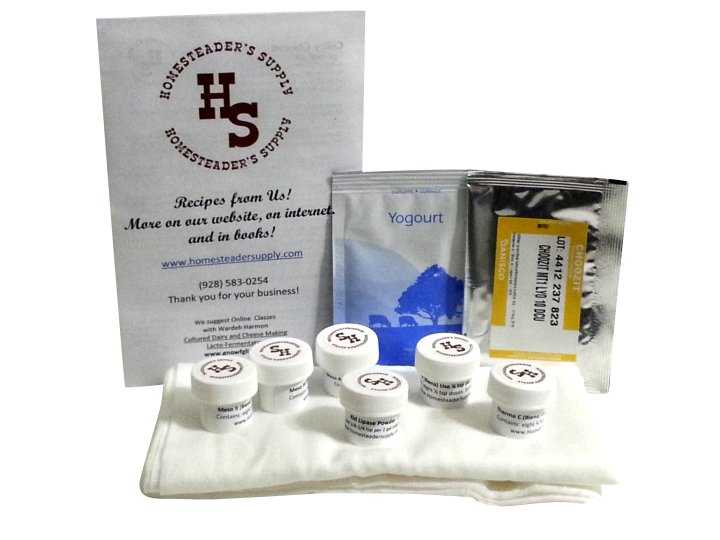|
|
Category Archives: Q&A
Q&A: What is early cheese blowing?
Gail asked My cheddar cheese looked just fine while I was making it. But later, when it came out of the Ultimate Cheese Press, it looked like a sponge with lots of holes throughout. Why did this happen? And is this cheese safe to eat?
Jerri’s answer This is called early cheese blowing. There are two reasons why it can happen.
One possible cause is coliform bacteria contamination. These pathogens can infect milk when sanitary conditions get compromised during milking or milk processing. You don’t want to risk getting sick, so THROW OUT THE CHEESE!
The second possibility is yeast contamination, which is most likely to happen when you’re baking fresh breads and making cheese in the kitchen at the same time. Again, I recommend you THROW OUT THE CHEESE!
The latter situation is easier to remedy. If you’re baking yeast breads while making cheese, add your lactic culture to the milk when it’s still cold, just prior to the first heating to start making cheese. This way, the lactic cheese culture will grow faster during the initial heating of the milk. If any yeast does get into the milk, it won’t be able to grow and ruin your cheese.
Q&A: Why won’t my mozzarella cheese stretch?
A customer asked Help! My mozzarella cheese won’t stretch!
Stretching mozzarella
Jerri’s answer Acidity is the key for the stretch in mozzarella. Not enough or too much acid will result in hard curd floating or disintegrating in the water. The pH of your slab needs to be between 5.0 and 5.2 for it to stretch well when kneaded in hot water.
And the ripening of your slab is very dependent upon the weather. It can over-ripen in hot weather, or under-ripen in colder weather. One trick to standardize your mozzarella making year round is to ripen your slabs in the refrigerator for 16 hours.
Would you like to try making mozzarella the old fashioned way at home? Our REAL Italian Mozzarella Kit makes cheese with authentic Old World flavor. The mesophilic and thermophilic cheese cultures we use to make our mozzarella are imported directly from Italy.
Q&A: Cheddar cheese came out dry and brittle. Why?
A customer asked: I followed the recipe perfectly, but my cheddar cheese came out dry, and it has a brittle texture. What did I do wrong?
Jerri’s answer: There are three possibilities:
- You might have inadvertently added too much starter culture. Excess starter culture can lower the pH below the desired level. This higher acidity can dry out your cheese. Remember, always use the correct dose of starter culture. Don’t think that if a little is good, then more is better. This is not true for cheesemaking!
- The cooking time directions weren’t followed properly. If the recipe says to raise the temperature 1 degree every 5 to 7 minutes, don’t try to speed up the process so you can finish sooner. Always follow your recipe exactly as written.
- Stirring too vigorously during the early stages of cheesemaking (before the curds are properly formed) causes too much whey to be released. This results in a curd that’s drier than normal. So, take your time, be gentle, listen to calming music… Do whatever it takes to allow yourself to relax and enjoy the cheesemaking process. And always follow the recipe directions exactly.
Q&A: Does It Hurt to Use Too Much Starter Culture?
A Customer Asked: Does it matter how much starter culture I use to make cheese or yogurt? Will it hurt if if I use too much? Sometimes I use the amount called for, and it doesn’t work. Should I add more?
Jerri’s Answer: Great question! You should always use the amount of starter culture specified in the recipe.
Starter culture contains the lacto-bacteria that grows when the milk is warmed. The culture helps create the acidic environment necessary for cheese curds to form, and for yogurt to set up properly. If you use too much culture, the milk will become too acidic and kill off the lacto-bacteria. And when the environment is too acidic, cheese curds won’t form and yogurt won’t set up as it should.
If curds didn’t form as expected even though you added the correct amount of rennet and starter culture, it’s often because there was problem with the milk. The milk might have come from a cow that had a sub-clinical infection. When undesirable micro-organisms are present in the milk, they can interfere with the process and prevent the rennet and starter culture from working. As a result, curds don’t form properly when making cheese. Similarly, when making yogurt, the starter culture is inhibited from working as it should, and your yogurt doesn’t set up to a thick consistency.
In these situations, it’s best to find a different source of milk and try again.
Q&A: How to Get the Best Deal on Shipping Costs
A customer asked: The shipping cost for an item I want to order from your website is reasonable if I order just one. But I need three of them, and the shipping costs seem much too high. I really need all three, but I don’t want to pay that much for shipping. Is there anything you can do to get me a better deal?
Jerri’s answer: Great question! Our website software isn’t always accurate when it comes to larger orders. It’s a math thing. What you need is personal assistance to calculate the correct shipping charges. We want you to have a good shopping experience, so please call us if you have questions when ordering. We will help you right there on the spot rather than sending you back to the website.
Also, just so you know…we reconcile the amount that gets charged for shipping with the actual shipping costs associated with each order. So if our website software should ever accidentally overcharge you for shipping, we would catch the error and refund the difference.




